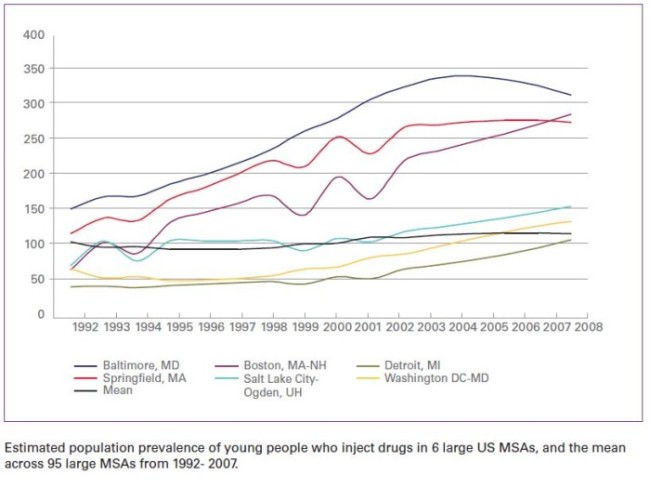Young People Who Inject Drugs are Increasing in the United States
Author: Center for Drug Use and HIV Research
Principal Investigator: Sam Friedman, PhD
Download Fact Sheet
Purpose of the study
- Young people who inject drugs (ages 15-29 years) face very high levels of risk for HIV, Hepatitis C virus (HCV), drug overdose, and sexually transmitted infections.
- It is important to monitor the prevalence of injection drug use among youth, that is, how many young people in the population inject drugs. This helps us understand the number of youth at risk for these poor health outcomes.
- Antiretroviral medication (ART) for HIV came into use in 1996. We hypothesized that injection drug use among young people would increase after the development of ART due to one or both of these reasons:
— They would perceive HIV as less of a threat now that there was effective treatment; or
— Young people would increasingly not have gone through the horrors that some communities of people who injected drugs (and their families and neighbors) went through during the height
of the AIDS epidemic.
Estimating the number of young people who inject drugs
- We conducted two recent studies to determine changes in the estimated number of young people who inject drugs aged 15-29 years from 1992-2007 in 95 metropolitan statistical areas (MSAs) of the United States.
- We used several data series to estimate the population prevalence of young people who inject drugs in MSAs. Multi-step approaches similar to those used in previous studies were employed to allocate the prevalence of young people who inject drugs in each MSA and to reduce biases in the data.
Main findings of the studies
- The number of young people who inject drugs (aged 15-29) declined between 1992 to 1995 and then increased from 1996 (mean = 96 per 10,000 youth) to 2002 (mean = 116 per 10,000 youth) [1]. The number of young people who inject drugs continued to increase through 2006-2007 (mean=>120 per 10,000 youth) [2].
- The more young people who inject drugs in a population in a given year, the more drug-related deaths and accidental and unintentional poisoning deaths there were that year. This provides support for the notion that young people who inject drugs are at high risk for these poor outcomes including death.

Implications
- Estimates of young people who inject drugs are important for planning and evaluating public health programs to reduce harm among young people who inject drugs and for understanding trends in social and health outcomes among youth.
- Increases in the number of young people who inject drugs are likely to lead to increased numbers of overdose deaths and HIV/AIDS, HCV and sexually transmitted infections.
- Recent increases in non-medical use of prescription opioids may lead new non-injecting opioid users to inject prescription opioids or transition to heroin or methamphetamine injecting.
- Should changes in socioeconomic conditions lead to declines in the size and effectiveness of harm reduction interventions, or otherwise lead young people who inject drugs into high-risk injection or sexual practices, the HIV epidemic among people who inject drugs may increase.
- Close monitoring of trends in the number of young people who inject drugs is necessary.
Policy Recommendations
- Target prevention, harm reduction, treatment programs and HIV testing and counseling for young people.
- Other young drug users might benefit from programs to prevent them from beginning to inject drugs.
- Increased funding for such targeted programs, including street outreach, is urgently needed.
THIS FACT SHEET IS BASED ON THE FOLLOWING ARTICLES:
- Chatterjee S, Tempalski B, Pouget ER, Cooper HL, Cleland CM, & Friedman SR (2011). Changes in the prevalence of injection drug use among adolescents and young adults in large U.S. metropolitan areas. AIDS and Behavior, v15, 1570-1578.
- Tempalski, B, Pouget, ER, Cleland, CM, Brady, JE, Cooper, HLF, Hall, HI, Lansky, A, West, BS, Friedman, SR (2013). Trends in the population prevalence of people who inject drugs in US Metropolitan Areas 1992-2007. PLOS ONE 2013. v8, 6, e64789.
Supported by a grant from the National Institute on Drug Abuse (R01DA0313360).
